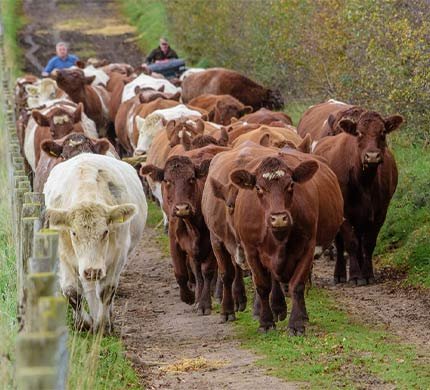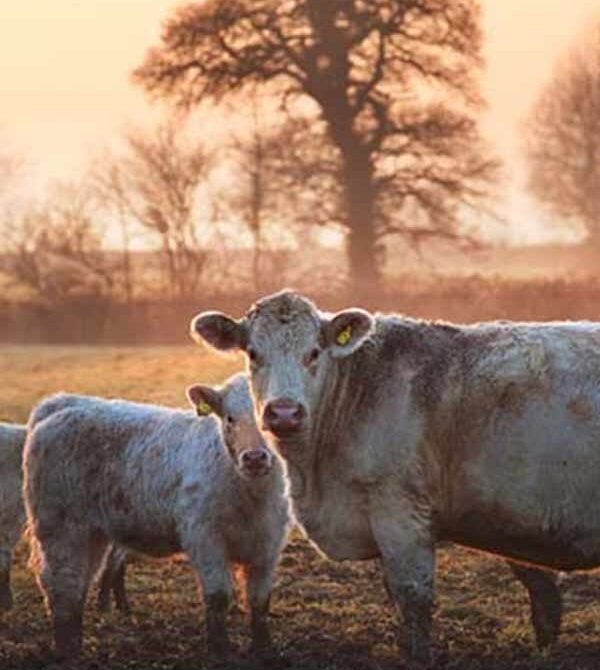Shorthorn Cattle
- Temperature:5°C (41°F) and 25°C (77°F)
- Milk:20-25 liters per day(3.5% butterfat)
- Food:Forage, hay or silage and grains
- Pregnancy:9 months(280-290 days)
- Nationality:Durham and Northumberland

General Information
Shorthorn cattle are a breed of cattle that originated in the northeast of England in the late 18th century. The breed was developed by cattle breeders in the region who aimed to produce a versatile breed of cattle that could be used for both beef and dairy production. The Shorthorn breed quickly gained popularity in England and was exported to other parts of the world, including the United States, Canada, Australia, and New Zealand.
Shorthorn cattle are medium to large-sized with cows weighing between 1,000 and 1,500 pounds and bulls weighing between 1,500 and 2,000 pounds. They have a distinctive short, smooth coat that can be red, white, or roan in color. Shorthorns have a well-muscled, deep body and a broad, straight back. They are adaptable to a wide range of climates and environments and are able to tolerate both hot and cold temperatures.
One of the distinguishing characteristics of Shorthorn cattle is their gentle and docile temperament. They are known for being easy to handle and work with, which makes them an attractive breed for both commercial and small-scale farmers. Their docile nature also makes them popular as show cattle, especially in youth competitions.
Shorthorn cattle are considered a dual-purpose breed because they can be used for both beef and dairy production. They are known for their high-quality beef, which is tender and flavorful. They also produce a good amount of milk with a high butterfat content. Shorthorns have a high fertility rate and are known for their ease of calving. This makes them an attractive breed for dairy farmers who want to maintain a high level of productivity in their herds.
The Shorthorn breed has a long and important history in the development of modern cattle breeds. They were one of the first breeds to be systematically bred and selected for specific traits, such as meat and milk production. Shorthorns were instrumental in the development of other popular breeds, such as the Hereford and the Angus. Today, Shorthorn cattle continue to be an important breed for both beef and dairy production around the world.
Where we find this cow to buy?
Shorthorn cattle can be found for sale through various channels, depending on the location and the purpose for which they are being purchased. Here are a few options:
01. Breeder Direct: One option is to purchase Shorthorn cattle directly from a breeder. Many Shorthorn breeders maintain their own herds and sell breeding stock to other farmers and ranchers.02. Auctions: Shorthorn cattle are often sold at livestock auctions. Auctions are a good place to find a variety of animals from different breeders and locations.03. Online Marketplaces: There are several online marketplaces where Shorthorn cattle can be purchased. These marketplaces often provide access to a wider range of animals than can be found locally, but buyers should exercise caution when purchasing animals sight unseen.04. Classified Ads: Another option is to look for classified ads in local or regional agricultural publications. These ads can be a good way to find animals for sale from breeders in your area.

How to increase milk production in Hereford cattle?
There are several factors that can affect milk production in Shorthorn cattle, including genetics, nutrition, management practices, and overall herd health. Here are a few strategies that can be used to increase milk production in Shorthorn cattle:
When selecting breeding stock, choose animals with a proven track record of high milk production.
Shorthorn cows need a balanced diet that provides all of the nutrients necessary for milk production. This includes adequate amounts of energy, protein, fiber, and minerals.
Cows need plenty of clean, fresh water to produce milk. Make sure that water sources are easily accessible and free from contaminants.
Proper herd management practices can help to ensure that cows are healthy and productive. This includes regular health checks and proper sanitation.
Milking technologies, such as milking machines, can help to increase milk production by removing milk more efficiently and effectively than hand milking.
Breeding programs can help to improve overall milk production in a herd by selecting for animals with the best milk-producing genetics.
Medicine
It’s important to note that the use of medications in Shorthorn cattle should always be done under the guidance of a veterinarian. It’s important to follow dosage instructions carefully and to ensure that meat and milk withdrawal periods are followed to avoid the risk of contamination. In addition, good management practices, such as maintaining a clean and sanitary environment and providing a balanced diet, can help to minimize the need for medications in the first place.
There are several medicines that may be used for Shorthorn cattle depending on their health condition.
01
AntibioticsAntibiotics may be used to treat bacterial infections. These may include mastitis and respiratory infections
02
Parasite ControlIt may be treated with dewormers to control internal and external parasites.
03
Pain ReliefThis medication may be used to treat pain and inflammation associated with many health conditions.
04
VaccinesVaccinations can help to prevent outbreaks of disease and minimize the need for antibiotics.

- Shorthorn cattle require a balanced diet of roughage, protein, energy, minerals, and vitamins to maintain their health and productivity. Roughage, such as hay and pasture, should make up the majority of their diet, with protein from sources like soybean meal and energy from corn, barley, and oats.
- Clean water should always be available, and feeding should be adjusted based on lactation stage and body condition. Working with a nutritionist or veterinarian can help develop a tailored feeding plan for Shorthorn cattle to optimize their health and productivity.
Important!
It’s important to ensure that Shorthorn cattle have access to clean water at all times, as dehydration can lead to health problems and reduced milk production. Feeding should be done on a regular schedule and should be adjusted based on the cow’s stage of lactation and body condition. Providing a balanced diet that meets the nutritional needs of Shorthorn cattle is essential for maintaining their health and productivity. Working with a nutritionist or veterinarian can help to develop a feeding plan that is tailored to the specific needs of your herd.
Pregnancy
The gestation period of a Shorthorn cow is approximately 9 months (280-290 days). During pregnancy, the cow requires adequate nutrition and veterinary care to ensure a healthy calf and cow.
The first and foremost step of a Shorthorn cow’s pregnancy is breeding. This can be done through natural breeding or through the artificial insemination.
During this time, it’s important to monitor the cow’s health and ensure that she receives proper nutrition, vaccinations and deworming treatments.
During this time, the cow will begin producing milk for the calf and if she is a dairy cow, will need to be milked regularly to maintain her milk production.
Facts
Shorthorn, also known as Durham, is a breed of cattle that originated in England in the late 18th century. Here are some facts about Shorthorn:
Original Shorthorns were bred for milk and beef. Their beef and milk are known for their quality.
Its curved horns and red, white, or roan coat color distinguish it from other breeds.
Shorthorns are popular for docile temperament, which makes them easy to handle.
In 1783, the breed was first imported to the United States and quickly gained popularity.
Hereford, Red Angus, and Santa Gertrudis are all cattle breeds developed from shorthorns.
A large amount of crossbreeding was done with Shorthorns during the 19th century.
A notable breed among dairy and beef farmers, shorthorns are gentle and charming.
Established in 1872, The American Shorthorn Association promotes and preserves Shorthorn.